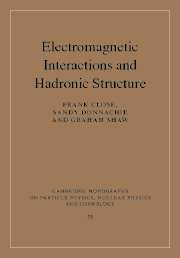Book contents
- Frontmatter
- Contents
- List of contributors
- Preface
- 1 Quark models of hadrons and issues in quark dynamics
- 2 Elastic form factors
- 3 Electromagnetic excitations of nucleon resonances
- 4 Meson radiative decays
- 5 Intermediate-energy photoproduction
- 6 Chiral perturbation theory
- 7 Spin structure functions
- 8 Diffraction and colour dipoles
- 9 Generalized parton distributions
- 10 Quark–hadron duality
- 11 Colour transparency
- Index
3 - Electromagnetic excitations of nucleon resonances
Published online by Cambridge University Press: 15 August 2009
- Frontmatter
- Contents
- List of contributors
- Preface
- 1 Quark models of hadrons and issues in quark dynamics
- 2 Elastic form factors
- 3 Electromagnetic excitations of nucleon resonances
- 4 Meson radiative decays
- 5 Intermediate-energy photoproduction
- 6 Chiral perturbation theory
- 7 Spin structure functions
- 8 Diffraction and colour dipoles
- 9 Generalized parton distributions
- 10 Quark–hadron duality
- 11 Colour transparency
- Index
Summary
It has long been recognized that the study of nucleon resonances (N*) is one of the important steps in the development of a fundamental understanding of strong interactions. While the existing data on the nucleon resonances are consistent with the well-studied SU(6) ⊗ O(3) constituent-quark-model classification, many open questions remain. On the fundamental level, there exists only very limited understanding of the relationship between QCD [1], the fundamental theory of strong interactions, and the constituent-quark model or alternative hadron models. Experimentally, we still do not have sufficiently complete data that can be used to uncover unambiguously the structure of the nucleon and its excited states. For instance, precise and consistent data on the simplest nucleon form factors and the nucleon–Δ(1232) resonance (N–Δ) transition form factors up to sufficiently high momentum transfer are becoming available. Thus the study of N* structure remains an important task in hadron physics, despite its long history.
With the development since the 1990s of various facilities with electron and photon beams, extensive data on electromagnetic production of mesons have now been accumulated for the study of N* physics. These facilities include JLab, LEGS at Brookhaven National Laboratory and MIT-Bates in the USA; MAMI at Mainz and ELSA at Bonn in Germany; GRAAL at Grenoble in France and LEPS at Spring-8 in Japan. The details of these facilities are summarized in [2] and will not be included here. The main purpose of this chapter is to review the theoretical models used in analysing these data, and to highlight the results obtained.
- Type
- Chapter
- Information
- Electromagnetic Interactions and Hadronic Structure , pp. 77 - 136Publisher: Cambridge University PressPrint publication year: 2007



